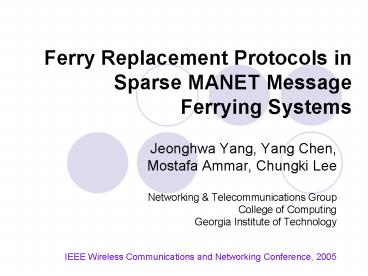Ferry Replacement Protocols in Sparse MANET Message Ferrying Systems - PowerPoint PPT Presentation
1 / 17
Title:
Ferry Replacement Protocols in Sparse MANET Message Ferrying Systems
Description:
If nodes need to send or receive messages, they adapt their trajectory to meet the ferry. ... responsibility to select a ferry replacement is distributed among ... – PowerPoint PPT presentation
Number of Views:103
Avg rating:3.0/5.0
Title: Ferry Replacement Protocols in Sparse MANET Message Ferrying Systems
1
Ferry Replacement Protocols in Sparse MANET
Message Ferrying Systems
- Jeonghwa Yang, Yang Chen,
- Mostafa Ammar, Chungki Lee
- Networking Telecommunications Group
- College of Computing
- Georgia Institute of Technology
IEEE Wireless Communications and Networking
Conference, 2005
2
Contents
- Background
- Message Ferrying System
- Problem Definition
- Ferry Replacement Protocols
- Concluding Remark
3
Background
- Ad hoc networks
- Connected networks
- Store-forward routing paradigm
- Most routing protocols
- Partitioned ad hoc network
- Wide deployment area, node mobility, limited
radio range, physical obstacles - Store-carry-forward routing paradigm
4
Message Ferrying System (cont.)
- Message ferrying system
- Developed by our group, Georgia Tech
- Designed as a routing strategy based on the
store-carry-forward paradigm for sparsely
distributed MANETs. - A set of special nodes, called ferries, are
responsible for delivering messages for all nodes
in the networks. - Exploits proactive mobility of ferries and nodes
W. Zhao, M. Ammar, and E. Zegura, A message
ferrying approach for data delay in sparse
mobile ad hoc networks, ACM Mobihoc, May 2004.
5
Message Ferrying System (cont.)
MF
6
Message Ferry Context
- A single ferry and a set of nodes are deployed.
- The ferry moves along the well-known ferry route
at possibly variable speed. - If nodes need to send or receive messages, they
adapt their trajectory to meet the ferry. - When the number of messages in a buffer reaches a
certain threshold or when a node wants to poll
the ferry - Each node is associated with different amount of
resources in terms of movement speed, buffer and
battery, which is represented by real numbers
called capability levels.
7
Ferry Replacement Protocols
- Intermittent but regular connectivity
- Howeversingle point of failure
- Graceful ferry stop vs. abrupt ferry failure
- Ferry replacement protocols in the presence of
the abrupt ferry failure
8
Problem Definition
- Problem statement
- Design a protocol that makes one and only one
ferry replacement substitute for the failed ferry
after the abrupt ferry failure. - Design considerations
- Recovery latency
- Protocol overhead on the ferry and nodes
- Success ratio of protocol
9
Ferry Replacement Protocols
- Successor designation protocol
- The responsibility to select a ferry replacement
is on the current ferry. - Distributed election protocol
- The responsibility to select a ferry replacement
is distributed among nodes
10
Successor Designation Protocol
- Successor designation
- Current ferry
- succ_cl_threshold
- Redesignation in case of the successor
failure - Ferry failure detection
- Successor
- Ferry status check every chk_interval
- ferry_cycle_time
- Ferry replacement in case of the ferry
failure
new ferry
CL gt succ_cl_threshold
successor
successor
successor
MF
MF
At time (t chk_interval)
At time (t)
11
Successor Designation Protocol (cont.)
Effect of the successors ferry status check
interval
Detection latency
Overhead
Ferry status check interval
Ferry status check interval
Movement overhead on successor and nodes
Failure detection latency
12
Distributed Election Protocol
- Ferry failure detection
- Potentially all nodes
- ferry_cycle_time
- Detector
- backoff_delay F(capability_level)
- Ferry election
- Candidate or elector
- capability_level
- highest_candidate (HC)
- WIN/LOSE message
9
backoff_delay
6
Elector1 HCc1(3)
3
backoff_delay
detector
candidate1
4
At time t1
13
Distributed Election Protocol
- Ferry failure detection
- Potentially all nodes
- ferry_cycle_time
- Detector
- backoff_delay F(capability_level)
- Ferry election
- Candidate or elector
- capability_level
- highest_candidate (HC)
- WIN/LOSE message
14
Distributed Election Protocol (cont.)
- Properties
- The election protocol ensures that exactly one
node is elected as a ferry after no more than
two rounds from the time the first node detects
ferry failure under the condition that there is
at least one elector. - Proof
- Base step of candidates 1
- Induction of candidates k, k gt 1
- Election failure
- The election protocol fails when there is no
elector forever
15
Distributed Election Protocol (cont.)
Effect of the backoff delay scale
Disrupted candidate ratio
Election latency
16
Concluding Remark
- Ferry replacement problem in the message ferrying
system in sparse MANETs - Two ferry replacement protocols
- Successor designation scheme
- Distributed election scheme
- Balance between performance and overhead by
tuning protocol parameters - Ferry replacement protocol in multiple ferry
systems
17
- Thank You!!
- jeonghwa_at_cc.gatech.edu































